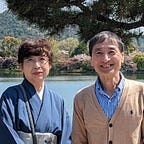An Intimate Exploration into Kyoto: Serene Solitudes & Timeless Tales
— Article 13: Nene Street in Bloom —
Nene Street, named after Nene, the wife of the 16th-century Japanese ruler Hideyoshi Toyotomi, stands as one of Kyoto’s most visited locales. Stretching from Yasaka Shrine to Kodaiji Temple and meandering through Maruyama Park, this path brims with historical resonance. My visit on March 27th, 2022, offered a glimpse into its rich tapestry.
Yasaka Shrine, established in the 9th century, represents a vibrant blend of color and history, a topic I will delve into in a forthcoming article. Eastward lies Maruyama Park, established post-Meiji Restoration in 1886. Renowned for its cherry blossoms, the park also features willow trees, a spring symbol in Chinese culture for millennia. Despite the usual festive ambiance under the cherry blossoms and willow leaflets, pandemic-related concerns thinned the crowds this year.
Kodaiji Temple, a creation of Nene in the early 17th century, stands as a testament to the complex interplay of power and respect in feudal Japan. Ieyasu Tokugawa, who dismantled the Toyotomi regime, notably supported its establishment, perhaps as a strategic gesture of respect towards Nene to pacify Toyotomi loyalists. The temple’s architecture, particularly the Kaizando and its front garden, is remarkable in its beauty. The site also includes Mitamaya, Nene’s subterranean entombment, and two historic tea rooms, Shiguretei and Kasatei, relocated from Fushimi Castle around 1600. The tea rooms’ names, translating to ‘a light drizzle’ and ‘umbrella,’ respectively, evoke poetic imagery.
Venturing into Ishibori Street, the westward extension of Nene Street, I found myself transported a century back in time, immersed in an era preserved.
For those yet to experience Kyoto’s serene elegance, I invite you to begin with my inaugural piece, “An Intimate Exploration into Kyoto: Serene Solitudes & Timeless Tales — Article 1: Lesser Known Gems.”
The next installment, “Saga Area in Bloom,” awaits to unveil the enchanting beauty of one of Kyoto’s most beloved landscapes.
